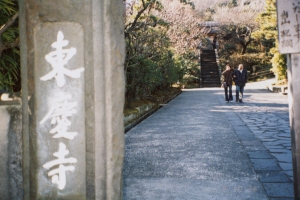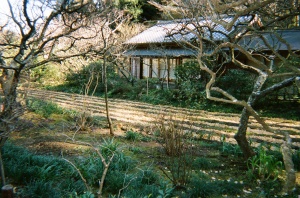Abbess Kakusan founded Tokeiji as a convent used as a sanctuary for women in distress. Naahime (Tenshu) escaped death at Osaka Castle and was spirited away to the safety of this sanctuary in Kamakura.
One of the most popular temples in Kamakura, for both Japanese and overseas tourists, is Tokeiji, the first sanctuary for women in Japan. It was a 10 minute walk from my home to this temple. There I first learned how samurai women had found safety in its Pine Grove Forest. In 1285, Lady Horiuchi, of the Adachi clan, established Tokeiji convent after the death of her husband Hojo Tokimune, the 8th regent of the Kamakura Shogunate (1185-1333).
In the beginning, the women who arrived there were victims of clan wars. However, when peace came to the country at the beginning of the Tokugawa (or Edo) period in 1600s, the women who arrived at the gates were mostly townsfolk who desired shelter from abusive husbands and in-laws.
Women Hostages and Runaways
Horiuchi took vows as a nun right before Hojo Tokimune died; she became Abbess Kakusan Shido. Tokeij’s convent lasted almost 700 years before being changed into a monastery. One of the reasons she used the convent as a sanctuary was that during infighting between the Hojo clan and the Adachi clan, part of her family was killed. The person responsible was her own son, Regent Hojo Sadatoki. It was a grueling aspect of the medieval period to experience the sudden break up of clans with families killed and women taken hostage. Women were also taken as hostages for political marriages. It was within this environment that Kakusan decided to use her convent as a sanctuary for women.

Kakusan (with Sadatoki) petitioned the emperorfor those who were in distress. According to Sachiko Kaneko Morrell in Zen Sanctuary of the Purple Robes, the petition stated, “being treated unjustly, some commit suicide or take other extreme measures. I request that this humble temple code provide that if such women reside in this convent for three years, the marital relationship will be severed.” Later, it was later changed to two years. The sanctuary continued until the convent was changed to a monastery in 1902 after women’s shelters and legal courts for divorce were established.
The Granddaughters of Hideyoshi and Ieyasu
Before Taiko Toyotomi Hideyoshi died in 1598, he requested Tokugawa Ieyasu and other daimyo to guarantee the safety of his son, Hideyori. Ieyasu broke his promise. In 1614-5, there were two sieges by Tokugawa forces against Hideyori at Osaka Castle where his wife Senhime, Ieyasu’s granddaughter; his mother, Yodogimi; and his children lived. Among those who rallied around Hideyori, were samurai who had converted to Christianity in the late 1500s and early 1600s before the persecutions of Christians grew. There were also samurai who were loners (ronin). Ieyasu and his son, Shogun Hidetada, won the battle with their greater strength of forces.
As Osaka Castle began to burn, Hideyori and his mother prepared for suicide as Senhime and her stepdaughter, Naahime, were allowed to leave the castle before it burned. Knowing that Tokeiji was a sanctuary, Senhime made sure that arrangements were made for the seven-year-old and some of her maids to escape by palanquin from Osaka to Kamakura. Unfortunately, Naahime’s eight-year-old brother was beheaded by the Tokugawa.
The Trauma of a Young Girl
What could it have been like for the small girl to be torn away by the death of her family and the only place she knew? Her ride to Tokeiji and safety was necessary so she would not be taken hostage or killed. As the palanquin was carried along the seaside route to Kamakura, what images of the battle and fire raced through her mind? Nahime only knew that she would become a nun at a forest temple for the rest of her life.
Sources from Catholic Priests and English Tradesmen
Japan experienced the arrival of Portuguese and Spanish priests in the 15th-17th centuries, as well as traders from England and the Netherlands. Some of them wrote diaries. One shipwrecked Englishman, Will Adams was able to establish a relationship with Ieyasu. He learned Japanese, became a samurai and a landowner in the Yokosuka. There was a yearly excursion to Edo for the priests and traders from Nagasaki in the south. Richard Cocks, the head of the East India Company, reported in his diary that he and Will Adams (as interpreter) passed through Kamakura on their way to Edo in 1616. Their remarks about the small daughter of Hideyori living at the Tokeiji convent were copied as the following (which was originally in Old English):
“The little daughter of Lord Hideyori took the tonsure to be a nun in Tokeiji, only to save her life, for it is a sanctuary & no justice may take her out.”
Richard Cock’s Diary entry for October 18, 1616.
The Hori Incident in History and Anime
Naahime was named Tenshu Hotai and eventually became the 20th abbess of Tokeiji. An alarming incident happened which shows her strength and courage. A daimyo, Kato Akinari was a cruel and decadent man who was outraged by advice from his loyal retainer, Hori Mondo. Hori sent his wife and children to Tokeiji for safety and hid from Kato. When Kato’s assassin arrived at Tokeiji, Tenshu refused to let the women them go. The assassin left because no man could enter the gate of Tokeiji’s sanctuary. There is a manga on the Hori Incident. It is greatly sensationalized, but the part about Tenshu and her continued correspondence with Senhime is quite accurate.
Abbesses Kakusan and Tenshu are exceptionally courageous samurai women. There is little written about women in medieval history. Legends of samurai women have been passed down and repeated in The Tales of Heike and other literature, but Kakusan and Tenshu were real people who studied, prayed, wrote poetry and helped other women who had no place to run to. In fact, Tokeiji is called the “run to temple” (kakikomidera).
This article is copyrighted by Carmen Sterba and first appeared in Suite 101 Online Magazine and Writer’s Network on May 15,2011.
Sources
Morrell, Sachiko K and Robert E. Morrell. Zen Sanctuary of Purple Robes: Japan’s Tokeiji Convent Since 1285, Albany, NY: State University of New York Press, 2006.
Rozmus, Lidia and Carmen Sterba, eds. The Moss at Tokeiji: A Sanctuary for Women in Kamakura (1285-1902), Santa Fe: Far North Press, 2010.
Tokeiji Official Website, Retrieved from http://www.tokeiji.com/


Dear Carmen, Things are running late at this point…but I hope to have time tonight to come back to this post. These posts of yours are always so full of the struggle and history of a great and brave people, and I am thankful that you bring them to us for us to learn from.
Wow! beautifully written.
Thank you. I lived a ten-minute-walk from the temple in Kamakura, which housed the runaway women, and lived a total of 30 years in Japan.
That is indeed one of life’s blessings. Stay happy and keep posting. 🙂
Thanks. I wrote a post on your site today. Lots of refreshing thoughts.
Really interesting 🙂 Keep posting!
I found this very interesting! great post on the history and life of people in Japan 🙂 I’m wanting to stopover in Japan, on my way to the US next August, so this gives me one area to research !